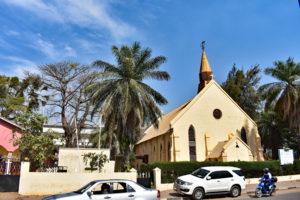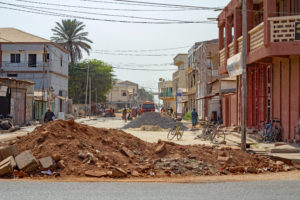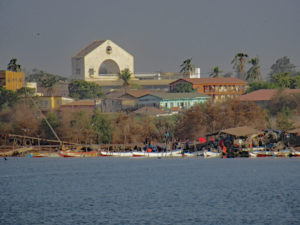Whilst sailing with “Variety Cruises” on their “Rivers of West Africa” cruise, we had a free afternoon in The Gambia’s capital, Banjul, which is located on an island.
Although the taxi fare from our mooring into the city centre was only 100 Dalasi (£1.50), we walked as we’d read it was a compact city with gridded roads which made navigation look pretty straightforward. However, the port area was incredibly noisy, dusty and busy with huge lorries unloading and loading, and having set off just after lunch, it was also very, very hot at around 38 degrees.
Our first destination was the Royal Albert Market where, having stopped to take photographs at the entrance, we were quickly ‘befriended’. We were told how marvellous the British were and then stalked as we wandered around. Eventually our friend tired with our lack of response and left us to negotiate the mass of stalls selling the usual clothes, household items, fruit, vegetables and fish. Although we’d been told it was arranged in sections, this wasn’t totally apparent. We eventually found the craft market and whilst people weren’t particularly pushy, we were invited to browse their wares. Bartering is the name of the game, and I successfully bought a wooden ‘teak’ bowl which, although it started at 1000, was secured for 200 Dalasi (£3.00).
We eventually made our way out of the market and back on to the main street passing State House which is not open to the public. The gate guards helpfully pointed us in the direction of the museum, which was reached by walking around the Victorian Recreation Ground, and past the locked, non-descript St Mary’s Anglican Cathedral. We inadvertently came across the Quadrangle or Government Building, housing the national archives, and eventually found the National Museum of the Gambia.
In front of the museum was a pleasant shaded garden where we stopped to cool down. The entrance fee was 100 dalasi each and 100 for a camera and although we paid for one camera, were told we could use both. The building, with original wooden floors, was formerly the Bathurst Club (Banjul was originally called Bathurst), and the objects, photos, sketches, maps and artists impressions were designed to give an insight into the history and culture of Banjul. The three floors had five themes: (1) Pre-European with information about the geography and geology and economic activities of the original settlers (2) Colonial Banjul, detailing the story of the occupation by the British from 1816, (3) the struggle for independence, (4) society and culture and (5) Post-colonial Banjul. The small basement contained traditional musical instruments. We spent a pleasant 45 minutes in what was a wonderfully cool, breezy building with fans and open windows.
It was then time to brave the heat again and return to our yacht, Harmony V. We took a different route back, which took us past the Cathedral of our Lady of Assumption, also closed, and the Sierra Leone High Commission.
We encountered very little hassle apart from a few ‘hellos’, ‘how are you’ and saw few tourists (the song ‘Mad dogs and English men go out in the midday sun’ sprang to mind). Even the children, who always crowded around when we moored up, were uninterested in us, although a few wanted a high five (or low five depending on their height). They also shouted ‘Toubab’ at us, which we’d been told was derived from “two bob” or the 2-shilling coin used when the country was still colonised by Britain. Many of the roads are in the process of being dug up, and as they were not well signed, we had a rather circuitous journey back via the industrial port some two and a half hours later (i.e. we got lost).
Despite being the country’s capital, there is little in Banjul to warrant more than half a day of sightseeing although with transport, we could have visited the Arch 22 Monument, a towering edifice over the only road into the town, or ventured off the island to the National Botanical Gardens and Kachikally Crocodile Pool and Museum. We were not tempted, as we drove under the monument on arrival, were told the gardens were small and had stroked a croc on a previous trip to The Gambia.
Our cruise was booked through “Seafarer Cruising and Sailing Holidays”:https://seafarersailing.co.uk/.










